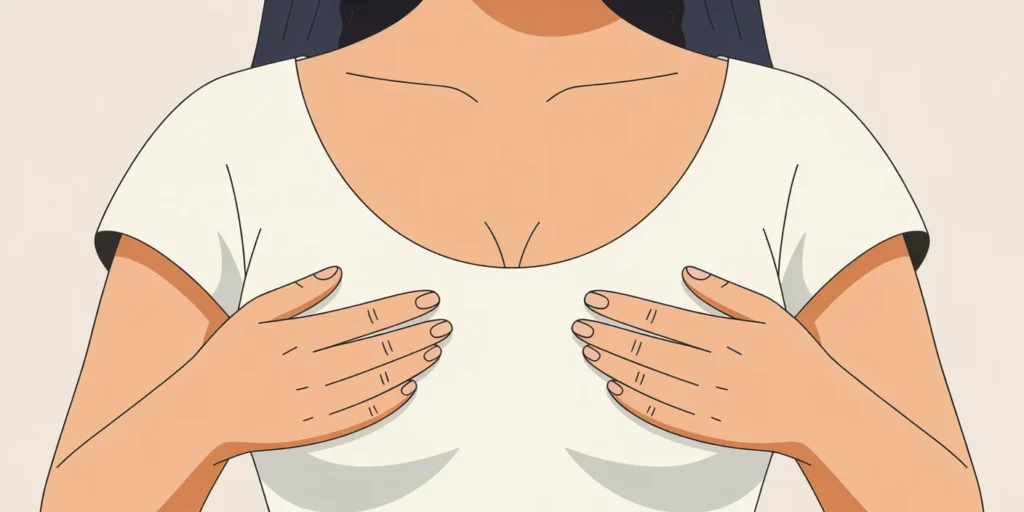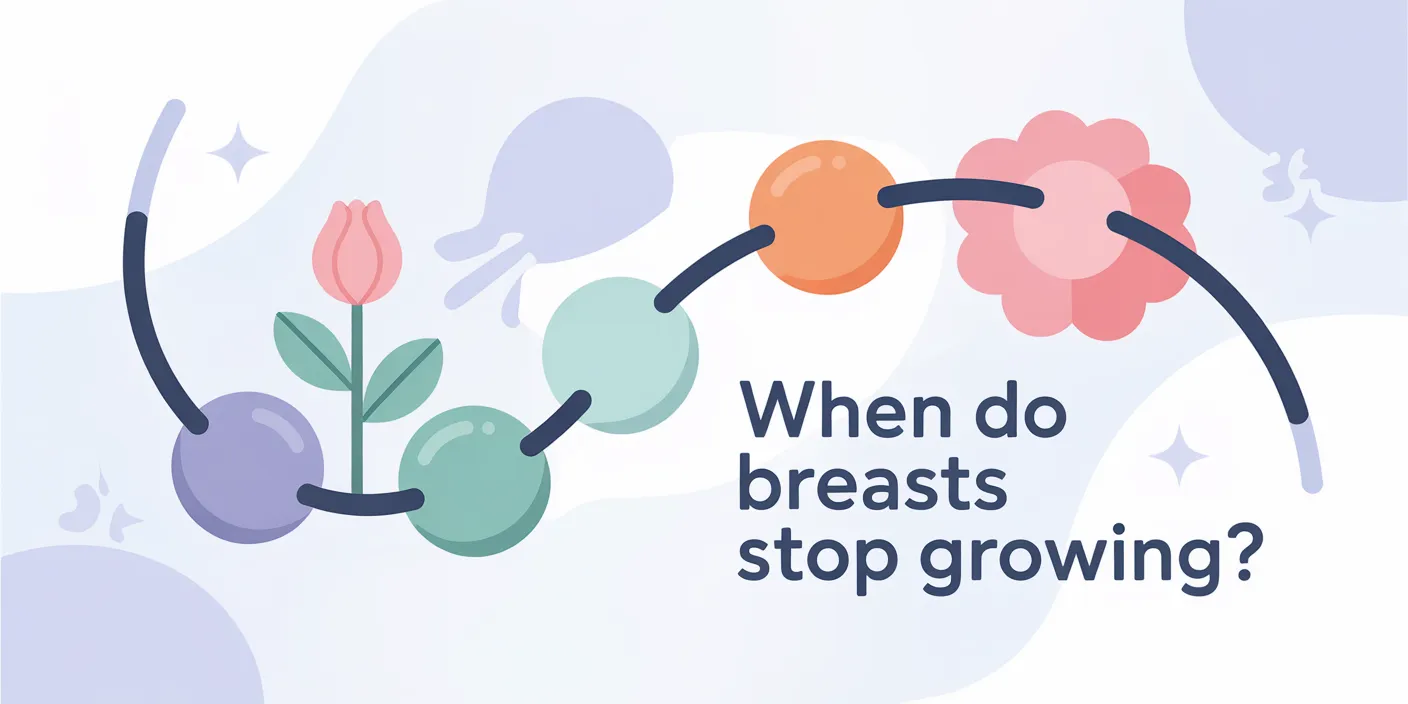When Breasts stop growing ? Many people think about this often as they negotiate puberty and beyond. Each individual has a different complex process for breast growth impacted by a symphony of hormones, genes, and life events. Though adolescence is the most important period of development, changes last a lifetime.
This page analyses the phases of breast development, investigates the elements affecting size and shape, specifies when the main period of growth usually ends, and addresses later in life modifications. Appreciating the natural changes of the human body requires knowledge of this journey. Together, let us investigate the science and chronology.
What age do your boobs start to grow?
Once gender is decided, a woman’s breasts begin to grow in the womb as the nipples and the beginning of the milk-duct system formed.
But the initial, outward indicators of breast development first show up during adolescence. Starting to release oestrogen, the ovaries bring about a range of physical changes. This includes the breasts swelling as the milk-duct system develops and little tissue growth under the nipples—often known as breast buds. Usually, these start between the ages of eight and thirteen.
Once a woman’s periods start, her breasts keep developing and maturing. At the end of the milk ducts, glands grow; this glandular tissue makes up most of the breast. The areola grows bigger as well. One can spend a few years completing this entire process.
When do women’s breasts stop growing?

Given many young women are self-conscious about their breast size, a particularly common search keyword is “at what age do breasts stop growing?” Though it might continue into your early twenties, most breasts stop developing at about age 18. Everybody grows at their own pace; there is nothing you can do to quicken this process.
There are many elements that will define the greatly varied breast size and form. Your genetics are the main determinant of your breast size; much as your family makeup determines your eye colour, so will this.
But your boob size will change over your life, especially in relation to your overall body size. Your breast consists of fatty and glandular tissue; if you have more of the latter, your breast size could alter whether you gain or lose weight. Your chosen activity can also impact the breasts since some weight-bearing activities boost muscle mass in the chest region, therefore enhancing their appearance.
Hormones also play a part; your breasts swell as you get ready for your period; some birth control drugs can also affect breast size. Naturally, breasts grow in size throughout pregnancy to get ready for lactation, which feeds the infant.
What’s Driving the Growth?
Let’s explore the Factors Influencing Breast Growth more closely to better understand what motivates these variations and how individualised they are.
Genetics: The Blueprint of Your Body
Consider your genetic composition as the initial blueprint for your body, including your breasts. Inherited from your parents, your genetic code pre-determines many features of your physical self, including height, skin tone, breast size and form. Should the ladies in your family have bigger breasts, you could also find yourself in a good position and vice versa. It’s comparable to how families can exhibit similar characteristics like height or eye colour.
Hormonal Changes: The Chemical Messengers
Essential for breast development, hormones are chemical messengers that set off growth. Important players here are especially oestrogen and progesterone. Rising levels of these hormones during puberty alert your body to initiate the process of breast growth. Still, these hormones influence your breasts all through your life. Changes in hormones throughout your menstrual cycle, pregnancy, menopause, or another condition can all affect breast size and sensitivity.
Nutrition and Lifestyle: Fuel for Growth
Additionally relevant for breast growth is the adage “You are what you eat”. Good eating supplies the building blocks needed for development. A diet high in all the required elements guarantees that your body can properly follow its genetic design. Furthermore, lifestyle choices like exercise can affect your total body fat, which determines breast size as breasts consist of fatty tissue.
What steps can you take if you are dissatisfied with your breast size?
Many women experience self-consciousness or unhappiness with their breasts’ size or form on a regular basis. The issue regularly comes up in breast augmentation consultations at our Centre for Surgery. Many young women ask, “At what age do boobs stop growing?” and demand clarity on the evolution of their breasts.
Once you beyond the time where your breasts are developing, there is a whole universe of options for adjusting their size ranging from basic at-home techniques straight through to more definite corrections.
Beginning with what you can do at home, adjusting your food and experimenting with some supplements can assist your skin remain flexible and potentially affect your hormones in a way that would modestly alter your breast size. Moreover, engaging in workouts like push-ups and chest presses will help the muscles under your breasts actually be worked. This not only helps your breasts feel firmer and fuller but also tones them somewhat and provides a little lift.
If you want alterations without resorting to surgery, there are some mild techniques worth giving thought. Little changes in the size of your breasts can come from utilising a vacuum bra or hormone treatment. The simple solution is to use special bras or inserts, which allow you to play about with how your breasts look each day you want without making any long-term commitment.
Those with limited breast tissue need not be concerned. A natural, proportionate outcome from a breast enlargement operation will improve your silhouette. Our knowledgeable plastic surgeons carefully assess every patient’s particular anatomy and needs. Particularly in respect to the width of the breast base, the choice of the suitable implant size is rather important. Sometimes putting the implants under the muscle would be the ideal way to guarantee the maximum safety and reach the intended result. Always keep in mind that your comfort and health come first, hence the objective is to highlight your natural attractiveness to get perfect-looking breasts.
Exploring Ways to Change Your Breast Size After Growth Has Stopped
If you are considering changing the size of your breasts and you have observed they are not getting any bigger, there are several techniques you might investigate. This could call for more major interventions as well as basic at-home routines.
Beginning with what you can do on your own, adjusting your diet and taking specific supplements will help somewhat with breast size by balancing your hormones and boosting the health of your skin. By strengthening the muscle under your breasts, exercises especially targeted at your chest—such as push-ups or chest presses—can also help to accentuate them.
Should you not be interested in surgery, there are still several really sensible approaches to make changes without resorting to surgery. Treatments that change hormone levels or hoover bra use can provide a modest size increase. Trying on various bras or employing inserts will help your breasts look more or more shapely simply for the day—a change that is simple but temporary.
For those seeking a more obvious and long-lasting transformation, surgery could be the path of choice. Your size will be much increased by breast augmentation, which can call for implants or fat transfer from another area of your body. Breast reconstruction could be the solution if size is not the only consideration; furthermore, shape or symmetry is. Additionally a breast lift is a choice if you want your breasts to appear perkier. Conversely, if big breasts are causing you pain or medical problems, you might want to think about reduction surgery.
Surgical Procedures for Changing Breast Size After Growth
Regarding modifying breast size following completion of growth, a few surgical techniques are especially praised for their efficiency and ability to fit individual preferences, thereby offering promising future improvements.
Breast Augmentation: For a more balanced figure, this is a great selection for individuals wishing to boost general shape and improve breast volume. Depending on what best fits your situation, the operation calls either silicone or saline implants or fat transfer from another body part to the breasts. Aiming for a natural and reasonable appearance, a consultation with your surgeon will help you decide the best augmentation technique.
Breast Lift: Targeting droopiness and a loss of form without changing size, a breast lift elevates the breasts to a more youthful and uplifting attitude. The tissue around the breast is tightened and extra skin is eliminated. Reshaping tuberous breasts and giving them a more normal look benefits greatly from this operation.
Breast Reduction: Reduction surgery could provide relief from physical discomfort or self-consciousness resulting from too big or heavy breasts. It involves the removal of extra skin, fat, and breast tissue, so producing a more reasonable breast size that reduces related discomforts such back or shoulder pain.
Revision Breast Surgery: Designed for patients who have undergone breast surgery in the past but now desire corrections—either for changes over time or discontent with initial results—revision surgery can change or replace implants. It is a necessary choice for handling issues following past procedures.
Starting any of these surgical routes calls for a thorough conversation with a trained plastic surgeon to make sure the selected operation fits your aesthetic objectives and medical situation. Our team of specialists at Centre for Surgery is committed to helping you travel this road and make sure your decision results in the confidence and satisfaction you are due.
If the content did not satisfy you, I leave here a youtube video if you want to know more.If the content did not satisfy you, I leave here a youtube video if you want to know more.
Final Thoughts on the Journey of Breast Development
Turning now back to our main concern: When will breasts stop growing? The most correct response is that, fuelled by the hormonal surge of puberty, the main developmental phase usually ends in the late teens or early twenties. This is when, following their genetic pattern, the basic glandular structure reaches maturity.
But the narrative doesn’t stop there. Breasts are still dynamic organs, sensitive to the continuous hormonal swings of monthly cycles, the significant alterations of pregnancy and nursing, the changes related with menopause, and differences in body weight over lifetime. Thus, even if the first building phase has a broad ending, changes and remodelling can go on endlessly.
Key is knowing this difference between later life alterations and basic developmental growth. A good relationship with your body might result from appreciating the natural variances in timing, size, and form and from emphasising breast health instead than just size.
Your experience with changes or development in breast size over life? Are you wondering anything else? Comments underneath allow you to share ideas or questions; let’s keep the discussion going!

